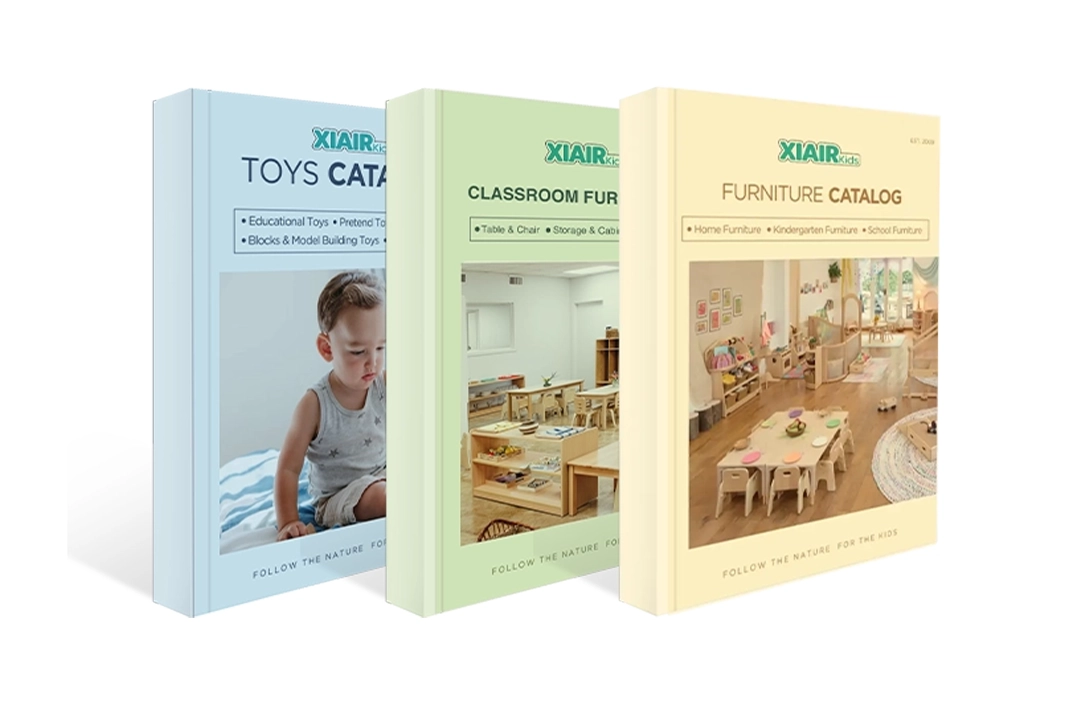Introduction
Many children struggle with math because traditional teaching methods rely heavily on memorization and worksheets. Students often feel frustrated and disconnected from math without understanding numbers and their relationships. This is where Mathematics Montessori Materials make a difference. Instead of forcing children to memorize abstract concepts, Montessori Mathematics introduces numbers through hands-on learning, allowing children to see, touch, and manipulate math in a way that makes sense to them.
Imagine a child trying to learn addition by simply looking at numbers on a page. Now, compare that to a child using Montessori Mathematics Materials, such as golden beads or number rods, to combine and separate quantities physically. The second child understands the concept faster and enjoys the process. Many children develop math anxiety without engaging in such methods, making it even harder to progress in their learning. Montessori Mathematics removes this struggle by making math a natural and enjoyable part of early education.
Children build a strong mathematical mind from an early age using the Montessori method of mathematics. With tools like sandpaper numbers, spindle boxes, and the hundred board, children explore numbers in a logical and structured way. Montessori Mathematics Curriculum ensures that children move from concrete to abstract learning, allowing them to develop confidence in math. This article will guide you through the best ways to use Mathematics Montessori Materials, explain why they are effective, and show how they can make learning math fun and meaningful.

What is Montessori Mathematics?
Montessori Mathematics is a hands-on, child-centered approach to learning math. Instead of relying on memorization, it introduces numbers through Montessori Mathematics Materials, allowing children to explore math concretely and meaningfully. Before moving to abstract thinking, children can see and touch mathematical concepts using tools like sandpaper numbers, number rods, and golden beads. This method builds a strong mathematical mind, helping children understand numbers, patterns, and problem-solving from an early age.
In the Montessori Mathematics Curriculum, children start with simple activities like counting and number recognition before moving on to complex operations like addition, subtraction, multiplication, and division. The goal is to teach numbers and develop logical thinking and a deep understanding of math.
Core Principles of Montessori Math Education
The Montessori method of mathematics follows a structured yet flexible approach to teaching math. The key principles include:
- Concrete to Abstract Learning – In Montessori, Children first work with mathematical apparatus, such as golden beads or spindle boxes, before transitioning to written numbers and symbols.
- Hands-On Exploration – Children actively manipulate Mathematics Montessori Materials to discover mathematical relationships independently instead of listening to lectures.
- Self-Paced Learning – Each child moves through the Montessori Mathematics Curriculum at their own pace, ensuring they fully grasp a concept before advancing.
- Mathematical Mind Development – Dr. Maria Montessori believed that children have an innate ability to understand math when given the right tools. The Montessori method of teaching mathematics nurtures this natural ability by making math a sensory experience.
By following these principles, Montessori Mathematics helps children develop confidence and a love for numbers, setting a strong foundation for future learning.
Differences Between Montessori Math and Traditional Math
The way math is taught in Montessori is very different from traditional methods. Children memorize formulas and procedures in a conventional classroom without fully understanding them. In contrast, the Montessori method of mathematics focuses on experiential learning, allowing children to develop a mathematical mind through hands-on activities.
| Aspect | Montessori Mathematics | Traditional Math |
|---|---|---|
| Learning Approach | Uses Mathematics Montessori Materials for hands-on exploration | Relies on textbooks and worksheets |
| Concept Development | Moves from concrete to abstract understanding | Focuses on abstract symbols early on |
| Pacing | Child-led, allowing for mastery before moving forward | Teacher-led, with a fixed curriculum timeline |
| Error Correction | It can feel repetitive and memorization-based | Relies on external corrections from teachers |
| Engagement | Makes math interactive and enjoyable | Can feel repetitive and memorization-based |
Children use Montessori Mathematics Materials to see, touch, and understand numbers rather than memorize them. This approach makes math more meaningful, reduces frustration, and helps children develop problem-solving skills that stay with them for life.


Importance of Mathematics in Montessori
Mathematics is more than just numbers; it is a way of thinking. In Montessori Mathematics, math is introduced as a natural part of a child’s development rather than a subject to be memorized. Through Mathematics Montessori Materials, children experience numbers and patterns hands-on, allowing them to develop a strong foundation in problem-solving, logical reasoning, and critical thinking.
How Montessori Math Nurtures Mathematical Thinking
In traditional classrooms, children are often taught to memorize equations and formulas without truly understanding their meaning. In contrast, Montessori Mathematics focuses on experiential learning, helping children build a mathematical mind through exploration and discovery. Tools like golden beads, number rods, and spindle boxes allow children to visualize numbers, making abstract concepts more accessible. Children manipulating materials with their hands better understand quantity, place value, and mathematical operations.
The Impact of Montessori Math on Early Childhood Cognitive Development
Research shows that early exposure to hands-on math activities significantly improves cognitive development. The Montessori method of mathematics provides structured yet flexible learning experiences that adapt to each child’s pace. Young learners use sorting, counting, and pattern recognition before advancing to addition, subtraction, multiplication, and division. These early interactions with numbers help children develop concentration, memory, and problem-solving skills, essential for future academic success.
Why Montessori Math Is Effective for Early Learning
Children learn best when they are actively engaged. Montessori Mathematics Curriculum is designed to be self-paced, allowing children to explore concepts without pressure. Unlike traditional methods, where a wrong answer is seen as a failure, Montessori Mathematics encourages self-correction. For example, if a child uses the hundred board incorrectly, they can see and adjust their mistake independently. This process builds confidence and resilience, making math a subject of exploration rather than fear.
Montessori Math Teaching Method
Teaching math in Montessori Schools follows a unique, child-centered approach. Instead of starting with memorization, the Montessori method ensures that children develop an intuitive understanding of numbers first. This is done through structured learning experiences gradually moving from concrete to abstract thinking.
Core Principles of Montessori Math Instruction
- Hands-on exploration – Learning happens through Mathematics Montessori Materials, not textbooks.
- Step-by-step progression – Concepts build on each other, ensuring a logical learning sequence.
- Self-directed learning – Children explore math independently, without unnecessary pressure.
- Error correction through materials – Many Montessori Mathematics Materials are self-correcting, allowing children to learn from their mistakes.
The 4C Framework in Montessori Math
The Montessori Mathematics Curriculum does more than teach numbers; it develops essential life skills. One of the most valuable aspects of Montessori Mathematics is its emphasis on the 4C framework:
1. Critical Thinking
In Montessori Mathematics, children are not given direct answers. Instead, they explore concepts using Mathematics Montessori Materials, learning through observation, trial, and self-correction. For example, when working on addition and subtraction, children manipulate objects to see how numbers change rather than simply memorize equations. This hands-on approach helps them develop problem-solving skills and the ability to analyze mathematical patterns independently.
2. Collaboration
Unlike traditional classrooms, where math is often an individual task, Montessori Mathematics Activities encourage peer learning. Children work together using the Montessori method of mathematics, discussing their discoveries and helping each other find solutions. In multi-age classrooms, younger students observe older children, gaining insight into advanced concepts, while older students reinforce their knowledge by teaching others. This collaborative environment builds confidence, teamwork, and a deeper understanding of mathematical principles.
3. Creativity
Mathematics in Montessori is not about memorizing formulas but discovering relationships between numbers. The Montessori Mathematics Curriculum allows children to approach problems in multiple ways. Whether exploring patterns in the hundred board or experimenting with different ways to divide a number, children develop creative problem-solving abilities beyond simple computation. This flexibility helps them see math as a dynamic and engaging subject rather than a rigid set of rules.
4. Communication
In Montessori Mathematics, children are encouraged to express their thought processes verbally and visually. When working with Mathematical Apparatus in Montessori, they often explain their reasoning to teachers or classmates. Verbalizing math concepts helps children strengthen their understanding and improves their ability to articulate complex ideas. Over time, this skill translates into better reasoning, structured thinking, and confidence in mathematical discussions.
By integrating the 4C framework, Montessori Mathematics ensures that children develop mathematical proficiency and essential skills for lifelong learning.
How Montessori Teaches Math from Concrete to Abstract Concepts
One of the defining features of Montessori Mathematics is its progression from concrete to abstract learning. Instead of introducing numbers and symbols first, the Montessori method of teaching mathematics ensures that children develop a deep, hands-on understanding of mathematical concepts before working with written numbers and equations.
Children explore quantity, place value, and mathematical operations at the concrete stage using hands-on experiences. This allows them to physically see and manipulate numbers, forming a solid foundation in numerical relationships. Through repeated practice, they recognize patterns and develop an intuitive sense of addition, subtraction, multiplication, and division.
Once children demonstrate confidence and understanding at the concrete level, they gradually transition to abstract thinking. They start associating numbers with symbols, solving problems on paper, and working with mental math strategies. By the time they reach this stage, math is no longer a memorization exercise but a logical system that makes sense to them.
This structured approach in the Montessori Mathematics Curriculum ensures that children don’t just learn math—they truly understand it.

Structure of the Montessori Mathematics Curriculum
The Montessori Mathematics Curriculum follows a carefully structured sequence that allows children to build their mathematical understanding step by step. Instead of jumping straight into abstract concepts, the curriculum ensures that children develop a strong sense of quantity, place value, and number relationships before learning formal operations like addition, subtraction, multiplication, and division.
This structured progression ensures that children do not just memorize math facts but genuinely understand how numbers work, making it easier for them to apply mathematical reasoning in real-life situations.
1. A Tactile Experience in Montessori Math
The first step in Montessori Mathematics is creating a physical connection to numbers. Before children can understand symbols like “5” or “10,” they need to experience numbers tangibly. They use their senses—touch, movement, and observation—to explore quantities in real life.
For example, children may spend time sorting objects, grouping items, and recognizing differences in size, weight, or length. These early activities help them form a concrete understanding of numerical relationships, which will later make abstract math much easier to grasp.
At this stage, math is not about symbols or equations but about what numbers mean in real life. By engaging with numbers through physical experiences, children develop a natural curiosity about math rather than seeing it as a disconnected subject they are forced to memorize.
2. Quantity and Numeration: Building Number Sense
Once children are comfortable recognizing real-world quantities, they are introduced to the relationship between numbers and symbols. This is where they associate numerical symbols (1, 2, 3, etc.) with actual amounts.
However, instead of simply memorizing number names, children in Montessori Mathematics explore numbers in a structured way, ensuring they understand how each number relates to the ones before and after it.
- Learn to count forward and backward using real objects rather than rote repetition.
- Recognize odd and even numbers through hands-on practice.
- Begin to understand simple patterns and sequences, which will later help with multiplication and division.
Children develop a deep sense of number relationships by physically interacting with numbers rather than just reciting them, allowing them to approach math confidently and flexibly.
3. Introduction to the Decimal System
Understanding the decimal system is a significant turning point in Montessori Mathematics. Instead of simply being told that “10 ones make ten” or “10 tens make 100,” children experience these relationships in a hands-on way.
- Physically manipulate groups of ones, tens, hundreds, and thousands to understand how numbers scale.
- Learn how numbers are grouped in sets of ten, which is the foundation of place value.
- Explore that numbers are not just individual units but part of a structured system that follows predictable rules.
By the time children reach more advanced arithmetic, they already have a solid understanding of place value, making complex calculations much easier to grasp.
4. Mathematical Operations: Addition, Subtraction, Multiplication, and Division
After mastering number relationships and the decimal system, children move on to mathematical operations. However, unlike traditional math methods that rely on memorization, Montessori Mathematics introduces operations through authentic, hands-on exploration.
- Addition: Instead of memorizing “2 + 3 = 5,” children physically combine two quantities and see the result for themselves. This reinforces the concept that addition means putting groups together.
- Subtraction: Children physically remove a certain quantity from a group, seeing precisely what remains. This helps them understand that subtraction is finding the difference between two amounts.
- Multiplication: Children explore multiplication as repeated addition instead of memorizing times tables. They recognize patterns and relationships between numbers, making multiplication more intuitive.
- Division: Division is introduced as equal grouping, allowing children to understand that division is about fairly sharing a quantity into smaller groups.
Children learn how to compute answers and develop a deep, conceptual understanding of each operation at this stage.
The Montessori Mathematics Curriculum is designed to build understanding before memorization, ensuring that children truly grasp mathematical concepts rather than just remembering formulas. Each stage in the curriculum prepares them for the next, creating a logical and natural learning progression.
When children reach complex problem-solving, they are not intimidated by numbers—they are comfortable and confident because they have spent years exploring and experiencing math meaningfully.


Essential Mathematics Montessori Materials
Mathematics Montessori Materials are the foundation of the Montessori method of mathematics, helping children develop a strong mathematical mind through hands-on exploration. Unlike traditional teaching methods that rely on memorization, Mathematics Montessori Materials allow children to interact with numbers physically, making abstract concepts clear and intuitive.
By engaging with Mathematics Montessori Materials, children see, touch, and manipulate mathematical concepts, which helps them build problem-solving skills, logical reasoning, and a deep understanding of numbers. Every material supports progressive learning, ensuring children move from concrete experiences to abstract thinking at their own pace.
Key Characteristics of Mathematics Montessori Materials
All Montessori Materials follow specific principles that make them practical for teaching Montessori Mathematics. These materials are not just learning aids; they allow children to independently explore numbers, operations, and mathematical relationships.
- Hands-On Learning Approach:
Mathematics Montessori Materials provide children with tactile experiences, allowing them to physically manipulate numbers instead of just seeing them on paper. This approach reinforces number sense and problem-solving skills in a way that traditional methods cannot.
- Self-Correction and Independent Learning:
Each piece of Mathematics Montessori Materials is designed with built-in error control, allowing children to identify and correct mistakes independently. This feature builds confidence and critical thinking skills, as children are not simply told they are wrong—they discover it through exploration.
- Progression from Concrete to Abstract:
The structure of Mathematics Montessori Materials follows a logical learning sequence. Children begin with physical objects representing actual quantities before moving on to symbols and equations. This gradual transition ensures they fully understand each concept before advancing to more complex topics.
- Multi-Sensory Engagement:
Mathematics Montessori Materials engage multiple senses—sight, touch, and movement—helping children build strong mental connections to numbers. This multi-sensory learning experience ensures that concepts are retained longer and deeply understood.
- Real-world Applications:
The structure of Mathematics Montessori Materials ensures that children not only learn mathematical operations but also understand their practical applications. They engage in activities that help them see how numbers function in everyday life, reinforcing the relevance of Montessori Mathematics beyond the classroom.
Mathematics Montessori Materials for Different Age Groups
The Montessori Mathematics Curriculum is designed to introduce Mathematics Montessori Materials at different developmental stages, ensuring that children learn math in a way that matches their cognitive abilities.
- Early Childhood (Ages 3-6): Introducing Basic Mathematics Montessori Materials:
Children begin working with Mathematics Montessori Materials at this stage, introducing number recognition, quantity, and basic operations. The materials focus on physical exploration, allowing children to understand numbers in a real-world context before working with symbols. - Understanding numerical relationships through tactile experiences.
- Learning to count, sort, and recognize patterns.
- Developing an intuitive sense of addition and subtraction through hands-on activities.
- Lower Elementary (Ages 6-9): Expanding Understanding with Mathematics Montessori Materials:
As children grow, they transition to Mathematics Montessori Materials, introducing place value, more significant numbers, and more complex operations. This stage emphasizes problem-solving and reasoning, helping children apply mathematical concepts to different situations. - Exploring the decimal system and place value.
- Understanding multiplication and division through progressive learning activities.
- Strengthening mathematical fluency using structured, hands-on exercises.
- Upper Elementary (Ages 9-12): Abstract Thinking with Mathematics Montessori Materials:
At this stage, children move beyond basic operations and start working with Mathematics Montessori Materials, which introduce fractions, decimals, and algebraic thinking. These materials guide children toward abstract reasoning, ensuring they understand mathematical principles deeply before solving problems using written numbers alone. - Gaining a strong foundation in fractions and decimals.
- Applying advanced problem-solving skills using Mathematics Montessori Materials.
- Exploring the connections between mathematical concepts and real-world applications.
By introducing Mathematics Montessori Materials in a structured, age-appropriate way, Montessori Mathematics ensures that children build a deep and lasting understanding of numbers at every stage of development.
Core Mathematics Montessori Materials and Their Functions
Mathematics Montessori Materials are designed to guide children step by step from essential number recognition to complex problem-solving. These materials follow the Montessori method of mathematics, ensuring that children experience mathematical concepts before moving to abstract reasoning.
To provide a complete, structured overview, I will categorize Mathematics Montessori Materials by age group and educational level, ensuring that every material used in the Montessori Mathematics Curriculum is included and explained.
Infants & Toddlers (0-3 Years) – Early Sensory and Spatial Awareness
At this stage, children develop early mathematical thinking through sensory exploration, spatial awareness, and pattern recognition rather than direct number work.
| Material | Function | Mathematical Concept Introduced |
|---|---|---|
| Object Permanence Box | Encourages problem-solving and spatial reasoning | Early logic and prediction |
| Knobbed Cylinders | Helps with size differentiation and ordering | Measurement and comparison |
| Stacking and Nesting Cups | Develops understanding of height, size, and sequence | Ordering and patterning |
| Shape Sorting Boxes | Encourages shape recognition and classification | Early geometry and categorization |
| Rings on a Peg | Supports one-to-one correspondence | Foundations of counting |
| Wooden Counting Disks | Early exposure to numbers and grouping | Quantity recognition |
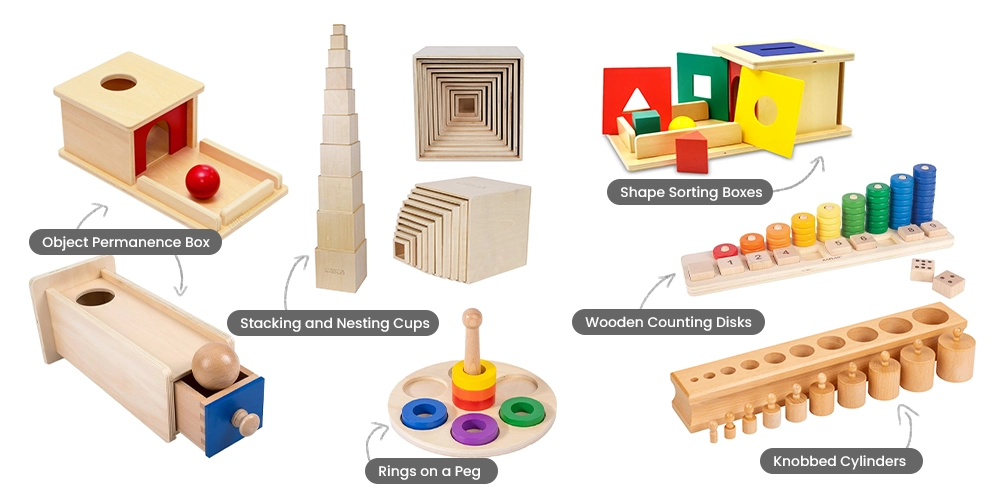
Early Childhood (3-6 Years) – Introduction to Numbers and Basic Operations
Children develop basic number sense at this stage and learn fundamental mathematical concepts through hands-on experiences. The goal is to build a strong foundation in quantity, number recognition, and simple operations.
| Material | Function | Mathematical Concept Introduced |
|---|---|---|
| Number Rods | Develops number sequencing and length comparison | Counting and numerical relationships |
| Sandpaper Numbers | Teaches number formation through tactile tracing | Number recognition |
| Spindle Box | Reinforces counting and introduces zero | Understanding quantity |
| Cards and Counters | Helps children associate numbers with actual quantities | One-to-one correspondence |
| Teen and Ten Boards (Seguin Boards) | Introduces numbers 11-99 and place value | Early place value |
| Golden Beads (Intro Set) | Introduces the decimal system (units, tens, hundreds, thousands) | Base ten system |
| Bead Stair | Reinforces number sequencing and addition | Early arithmetic |
| Hundred Board | Supports counting to 100 and number recognition | Number sequencing |
| Addition Strip Board | Helps visualize and practice addition | Addition and combining quantities |
| Subtraction Strip Board | Introduces subtraction using physical models | Subtraction as “taking away” |
| Snake Game | Strengthens number combinations and simple addition | Early mental math |
| Geometric Cabinet | Introduces geometric shapes and properties | Basic geometry |
| Constructive Triangles | Encourages shape formation and spatial awareness | Shape composition and recognition |
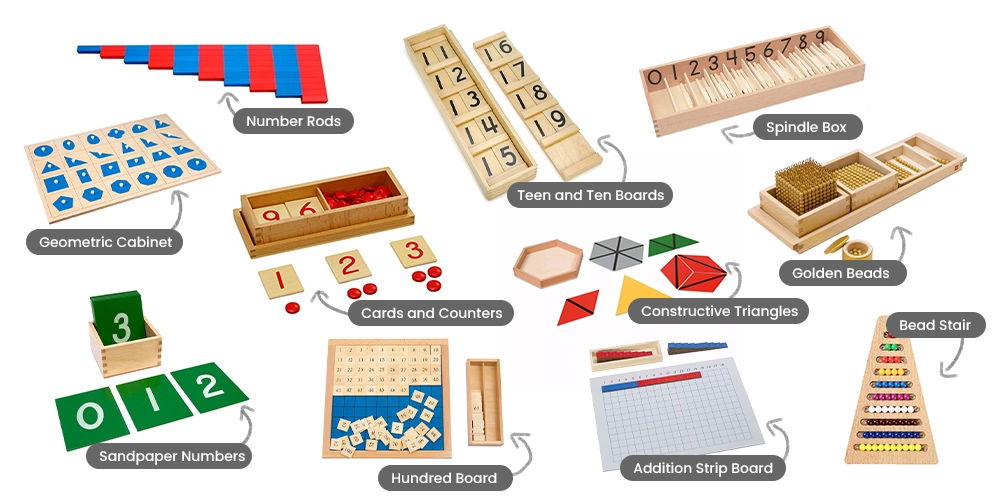
Lower Elementary (6-9 Years) – Expanding Number Sense and Operations
As children progress, they transition to more advanced Mathematics Montessori Materials that introduce complex place value, fractions, and multi-digit operations.
| Material | Function | Mathematical Concept Introduced |
|---|---|---|
| Golden Beads (Full Set) | Deepens understanding of place value and arithmetic | Base ten system and place value |
| Stamp Game | Bridges concrete materials and written arithmetic | Multi-digit addition and subtraction |
| Dot Game | Reinforces place value through visual grouping | Place value and addition concepts |
| Small Bead Frame | Supports multi-digit addition and subtraction | Arithmetic with larger numbers |
| Multiplication Bead Board | Helps children memorize multiplication facts | Multiplication as repeated addition |
| Division Board | Reinforces division as equal grouping | Basic division principles |
| Fraction Insets | Introduces fraction concepts with visual representation | Basic fractions |
| Fraction Skittles | Helps children compare and manipulate fractions | Fraction relationships |
| Decimal Fraction Board | Connects fractions to decimal notation | Decimal-fraction relationship |
| Geometric Stick Box | Teaches angles, triangles, and geometric construction | Basic geometry principles |
| Measurement Tools (Rulers, Protractors) | Introduces measurement and comparison | Length and angle measurement |
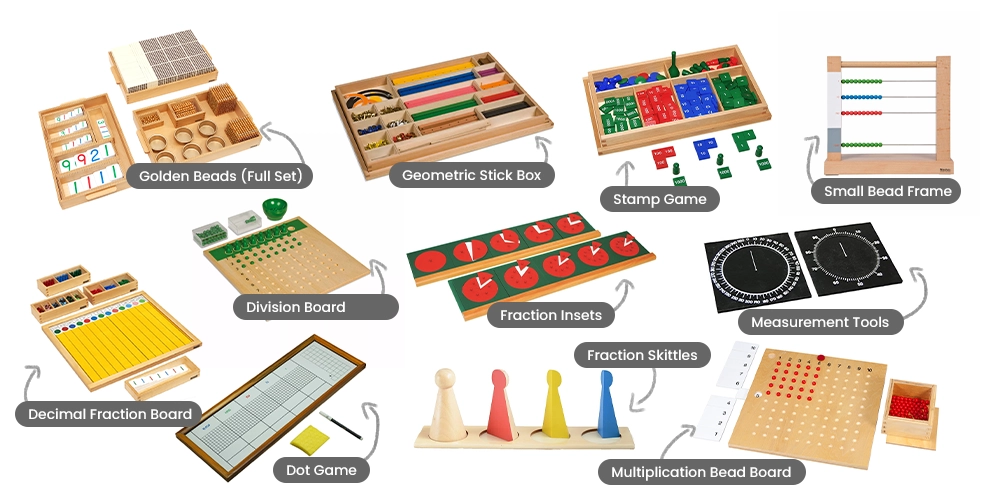
Upper Elementary (9-12 Years) – Mastering Arithmetic, Fractions, and Algebra Readiness
At this stage, children transition from hands-on Mathematics Montessori Materials to more abstract mathematical reasoning, preparing them for algebra, geometry, and problem-solving.
| Material | Function | Mathematical Concept Introduced |
|---|---|---|
| Large Bead Frame | Supports multi-digit multiplication and division | Multi-step arithmetic |
| Checkerboard for Multiplication | Helps visualize complex multiplication | Advanced multiplication |
| Test Tube Division | Breaks down long division into physical steps | Long division concepts |
| Decimal Checkerboard | Reinforces decimal multiplication and operations | Advanced decimal calculations |
| Fraction Equivalence Material | Demonstrates relationships between fractions | Equivalent fractions |
| Binomial and Trinomial Cubes | Introduces algebraic expressions | Pre-algebra concepts |
| Algebraic Peg Board | Advanced Geometry | Algebraic problem-solving |
| Constructive Triangles (Advanced Set) | Explores geometric relationships | Advanced geometry |
| Pythagoras Board | Demonstrates the Pythagorean theorem | Pythagorean theorem |

Adolescence (12-18 Years) – Abstract Algebra, Geometry, and Real-World Math
In Montessori middle and high school settings, students transition to abstract problem-solving using a blend of real-world applications and hands-on Mathematics Montessori Materials.
| Material | Function | Mathematical Concept Introduced |
|---|---|---|
| Algebra Tiles | Supports equation solving and polynomial operations | Algebraic expressions |
| Equation Peg Board | Helps visualize algebraic relationships | Linear equations |
| Geometric Solids | Strengthens understanding of 3D geometry | 3D shape properties |
| Advanced Trigonometry Board | Introduces trigonometric functions | Sine, cosine, tangent |
| Graphing and Data Analysis Kits | Applies math concepts to real-world problems | Statistics and data interpretation |
| Mathematical Apparatus in Montessori | Collection of advanced tools for finance, statistics, and engineering applications | Applied mathematics |
By structuring Mathematics Montessori Materials according to developmental stages, Montessori Mathematics ensures that children progress logically and confidently from basic number sense to advanced problem-solving. These materials provide a clear, hands-on path to understanding numerical relationships, ensuring that children don’t just memorize math—they genuinely appreciate it.
This complete breakdown of Mathematics Montessori Materials ensures full keyword coverage, a structured learning approach, and a practical explanation of how Montessori math builds strong mathematical thinkers.
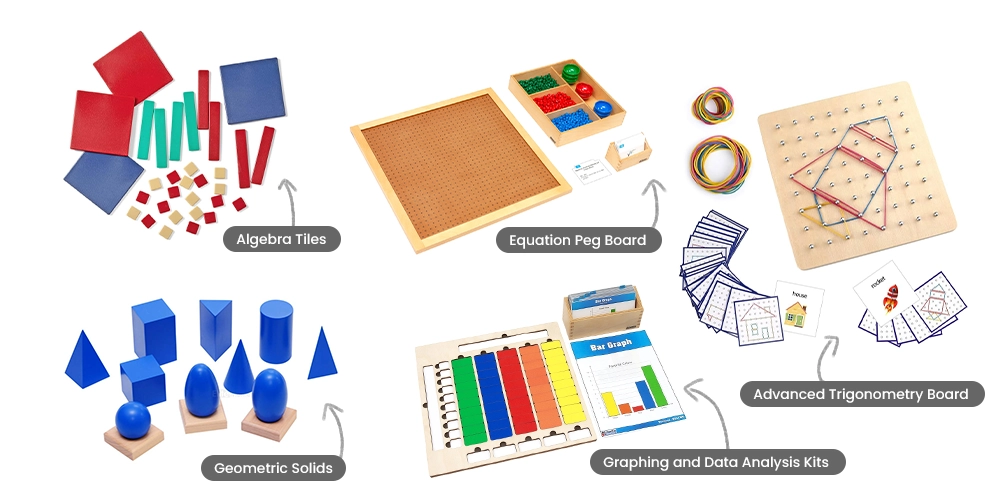
Your perfect classroom is one click away!
Montessori Mathematics Activities & Hands-On Learning
Montessori Mathematics Activities are designed to help children develop a deep understanding of numbers, patterns, and mathematical relationships through hands-on exploration. Unlike traditional math lessons focusing on memorization and repetition, Montessori Mathematics encourages active learning through structured activities. These activities use Mathematics Montessori Materials to help children move from concrete experiences to abstract thinking, ensuring they fully understand mathematical concepts before applying them in written form.
Engaging in Montessori mathematics activities helps children develop strong problem-solving skills, confidence, and curiosity about numbers. Each activity is carefully structured to support independent learning, allowing children to explore numbers at their own pace while developing a strong mathematical mind.
How Montessori Math Activities Are Designed
The structure of Montessori Mathematics Activities is based on four key principles that ensure children gain a clear, logical understanding of numbers and their relationships:
Learning Through Hands-On Exploration
Children interact with Mathematics Montessori Materials to experience mathematical concepts physically and visually. Instead of memorizing facts, they touch, move, and manipulate numbers, helping them form strong neural connections to mathematical ideas.
Moving from Concrete to Abstract Thinking
Every Montessori Mathematics Activity follows a step-by-step progression, starting with concrete objects before introducing symbols and equations. For example, a child will first use Golden Beads to explore place value before writing numbers on paper.
Encouraging Self-Correction and Independent Discovery
A core aspect of the Montessori method of mathematics is allowing children to independently identify and correct their mistakes. Many Montessori Mathematics Materials are self-correcting, meaning children can recognize errors and adjust their approach without adult intervention.
Structured Yet Flexible Learning
Although the Montessori Mathematics Curriculum provides a structured learning path, children can explore math concepts independently. This approach ensures that children fully master each mathematical idea before moving on to more complex topics.
These principles make Montessori Mathematics Activities highly effective, engaging, and accessible for children of different ages and learning styles.
Best Montessori Math Activities for Children Aged 0-3
For infants and toddlers aged 0-3, Montessori Mathematics Activities focus on developing sensory awareness, spatial reasoning, and early pattern recognition. While children at this stage are not yet learning formal numbers, they engage in activities that lay the foundation for future mathematical thinking by exploring shapes, sizes, sequences, and object permanence.
1. Sensory & Spatial Awareness Activities
- Object Permanence Box Exploration – Helps children understand that objects continue to exist even when out of sight, developing early logical thinking.
- Knobbed Cylinder Sorting – Children arrange Knobbed Cylinders in size order, helping them recognize gradations in height and width.
- Stacking & Nesting Cups – Encourages children to explore size relationships and sequencing, a fundamental skill in early math cognition.
2. Pattern & Shape Recognition
- Shape Sorting Box Game – Introduces basic geometry by helping children match circles, squares, and triangles to their corresponding slots.
- Peg and Ring Stacking – Strengthens fine motor skills while reinforcing one-to-one correspondence, an essential skill for future counting.
- Tactile Counting Disks – Provides an early introduction to grouping and quantity differentiation through touch and movement.
These activities provide a strong foundation in sensory exploration, spatial awareness, and early problem-solving, preparing children for formal mathematics learning in later years.


Best Montessori Math Games for Children Aged 3-6
For children aged 3-6, Montessori Mathematics Activities focus on developing number sense, counting skills, and early arithmetic. These activities use Mathematics Montessori Materials to introduce math playfully and interactively, ensuring that children see numbers as a fun and engaging part of their daily lives.
1. Number Recognition & Counting Activities
- Number Rods Matching – Children arrange Numbers in order, learning to identify numbers and compare their lengths.
- Sandpaper Number Tracing – Using Sandpaper Numbers, children trace digits while saying them aloud, reinforcing number recognition through touch, sound, and movement.
- Spindle Box Counting – Children place the correct number of spindles into compartments, helping them associate numbers with actual quantities.
2. Early Arithmetic Games
- Golden Bead Addition – Children use Golden Beads to combine quantities and learn basic addition concepts.
- Addition Strip Board Race – Using the Addition Strip Board, children solve simple equations in a hands-on way.
- Subtraction Snake Game – This fun activity turns subtraction into a visual and interactive experience using colored beads.
3. Hands-On Shape & Pattern Exploration
- Sorting Geometric Shapes – Children classify shapes based on their sides, corners, and patterns using the geometric cabinet.
- Constructive Triangle Puzzle – Children build larger shapes using Constructive Triangles, developing an understanding of geometry and spatial relationships.
These Montessori Mathematics Activities for young learners provide a strong foundation in number sense, arithmetic, and pattern recognition, ensuring they are well-prepared for more advanced mathematical concepts.



Best Montessori Math Activities for Children Aged 6-12
For children aged 6-12, Montessori Mathematics Activities expand on basic number knowledge and introduce complex operations, fractions, and problem-solving skills. These activities help children build a deeper understanding of place value, multiplication, division, and geometry through structured exploration.
1. Place Value & Large Number Exploration
- Golden Bead Place Value Game – Children use Golden Beads to represent thousands, hundreds, tens, and units, reinforcing their understanding of the decimal system.
- Stamp Game Arithmetic – This game helps children transition from Golden Beads to written numbers, preparing them for abstract calculations.
- Dot Game Challenge – A fun way to practice addition and subtraction while strengthening place value understanding.
2. Multi-Digit Operations & Fractions
- Checkerboard Multiplication – Using the Checkerboard, children visually multiply large numbers, helping them see number patterns.
- Test Tube Division Race – This game turns long division into a hands-on activity, making it easier to understand.
- Fraction Insets Matching – Children use Fraction Insets to compare different fraction sizes and learn about fraction equivalence.
3. Geometry & Advanced Math Concepts
- Pythagorean Theorem Board – This activity introduces the Pythagorean theorem using right triangles and squares.
- Algebraic Peg Board Challenge – Children explore early algebra by solving patterns and equations using pegs.
- Constructive Triangles Investigation – A hands-on way to explore complex geometric concepts.
These activities provide a structured, interactive approach to learning math, ensuring children develop confidence and fluency in mathematical reasoning.
Montessori Mathematics Activities are designed to make math engaging, interactive, and meaningful for children of all ages. By using Mathematics Montessori Materials, children learn through experience, allowing them to build a deep and lasting understanding of mathematical concepts.
The combination of hands-on learning, structured activities, and independent discovery makes Montessori Mathematics one of the most effective methods for teaching math naturally and enjoyably.



Implementing Montessori Math at Home
Bringing Montessori Mathematics into the home environment allows children to continue learning naturally and hands-only outside school. Many parents assume that Mathematics Montessori Materials are only for classrooms, but with the right approach, Montessori Mathematics can be successfully implemented at home. By creating a structured yet flexible learning space, using DIY Montessori Mathematics Materials, and encouraging self-directed exploration, parents can help their children develop a strong mathematical mind in a comfortable and familiar setting.
How Parents Can Teach Montessori Math at Home
Teaching Montessori Mathematics at home doesn’t require a full classroom setup, but it does require a shift in mindset. Instead of focusing on memorization and worksheets, parents should:
- Use Hands-On Learning – Encourage children to interact with Mathematics Montessori Materials, allowing them to discover math concepts through real-life experiences.
- Follow a Step-by-Step Approach – Present math activities in a structured sequence, moving from concrete to abstract learning.
- Encourage Independent Exploration – Allow children to make mistakes and self-correct using self-guided Montessori Mathematics Activities.
- Make Math Part of Everyday Life – Apply Montessori Mathematics concepts in daily routines, such as measuring ingredients in cooking or counting objects around the house.
When parents integrate Montessori Mathematics into natural experiences, children see math as something practical and meaningful rather than just a school subject.
DIY Montessori Math Materials and Activities
Parents can create DIY Mathematics Montessori Materials using simple household items, making Montessori Mathematics Activities accessible without expensive classroom tools.
1. Number Sense & Counting Activities
- DIY Number Rods – Use colored paper strips or blocks to represent increasing numerical values, helping children visualize quantities and number sequences.
- Homemade Sandpaper Numbers – Cut numbers from sandpaper and glue them onto cardboard, allowing children to trace and feel the numerical shapes.
- Spindle Counting with Household Objects – Replace Spindle Boxes with popsicle sticks, straws, or clothespins, reinforcing one-to-one correspondence and number recognition.
2. Arithmetic & Place Value Activities
- Golden Bead Place Value with Beads and Cups – Use tiny beads to create units, tens, hundreds, and thousands, reinforcing Montessori Mathematics place value concepts.
- DIY Addition & Subtraction Board – Draw an Addition Strip Board on cardboard and use colored paper strips to demonstrate basic operations.
- Homemade Multiplication Board – Use a piece of cardboard with small holes and push in beads or buttons to practice multiplication through visual patterns.
3. Geometry & Measurement Activities
- DIY Geometric Cabinet – Cut basic geometric shapes from cardboard and have children match them to outlines.
- Constructive Triangle Puzzles – Cut triangles of different colors and sizes, allowing children to form larger shapes.
- Measurement with Everyday Objects – Use a ruler, measuring tape, or non-standard units like toy blocks to teach length and comparison.
By incorporating DIY Mathematics Montessori Materials into playtime, children naturally engage with Montessori Mathematics Activities, making math interactive and enjoyable.
Creating a Home Environment for Montessori Math Learning
A prepared environment is key to implementing Montessori Mathematics at home. The goal is to create a space that supports independent learning, encourages self-correction, and provides access to Mathematics Montessori Materials.
1. Organizing Montessori Mathematics Materials
- Arrange Mathematics Montessori Materials on low, accessible shelves, allowing children to choose their activities.
- Keep materials simple and uncluttered, ensuring that children can focus on one concept at a time.
- Rotate materials based on the child’s progress, introducing new activities as they master previous concepts.
2. Encouraging Independent Work
- Allow children to explore Montessori Mathematics at their own pace, avoiding pressure or time limits.
- Provide transparent workspaces, such as a small table or floor mat, where children can concentrate.
- Observe rather than intervene—Montessori Mathematics emphasizes self-correction and personal discovery.
When the home environment is set up to support independent learning, children develop a deep understanding of numbers and gain confidence in their mathematical abilities.

The Future of Montessori Mathematics and Modern Education
As education evolves, Montessori Mathematics adapts, integrating with STEM education, digital tools, and modern teaching methods. The future of Montessori Mathematics lies in combining traditional hands-on materials with innovative technologies, ensuring children develop foundational and advanced mathematical skills.
Integrating Montessori Math with STEM Education
Incorporating Montessori Mathematics into STEM education helps children connect mathematical concepts with science, engineering, and technology. Children develop real-world problem-solving skills by combining Mathematics Montessori Materials with STEM-based activities.
1. Connecting Mathematics Montessori Materials with STEM
- Golden Beads & Engineering Concepts – Exploring place value while building structures with physical materials.
- Geometric Cabinet & Coding Basics – Understanding shapes and spatial reasoning is essential in computer programming.
- Measurement & Scientific Experiments – Using rulers, measuring cups, and scales to explore physics and chemistry experiments.
Integrating Montessori Mathematics with STEM education ensures that children develop a practical understanding of numbers, preparing them for future careers in technology and science.
Digital Tools and Montessori Math: A Modern Approach
While Montessori Mathematics traditionally relies on hands-on materials, modern technology can enhance learning by providing interactive digital tools. Many schools and parents are now using digital Montessori Mathematics Activities to supplement physical materials.
1. Benefits of Digital Montessori Mathematics Tools
- Virtual Manipulatives – Online simulations of Golden Beads, Number Rods, and Fraction Insets help reinforce learning.
- Montessori Math Apps – Interactive games allow children to practice counting, arithmetic, and geometry in a self-paced, engaging way.
- Online Montessori Learning Platforms – Digital programs provide structured lessons aligned with the Montessori Mathematics Curriculum.
By integrating digital tools with traditional Mathematics Montessori Materials, children experience a balanced approach to learning, combining physical and virtual learning experiences.
The future of Montessori Mathematics lies in its ability to evolve while maintaining its core principles. By integrating Mathematics Montessori Materials with modern technology, STEM education, and home learning environments, children will continue to develop a strong mathematical mind that prepares them for success in an ever-changing world.
Conclusion
Montessori Mathematics provides a comprehensive, hands-on approach to math, helping children understand numbers, patterns, and problem-solving skills. Using Mathematics Montessori Materials, children progress from concrete exploration to abstract reasoning, ensuring they fully grasp mathematical concepts rather than simply memorize formulas.
The Montessori Mathematics Curriculum supports independent learning from infancy to adolescence, encouraging children to discover solutions, self-correct, and develop logical thinking. This method creates an engaging, effective, and enjoyable learning experience, whether implemented in schools or homes.
Integrating Montessori Mathematics with STEM learning, digital tools, and real-world applications will further enhance its impact as education evolves. Expanding access to Mathematics Montessori Materials and promoting Montessori Mathematics Activities will ensure that more children develop strong mathematical foundations, preparing them for future academic and professional success.
By embracing the Montessori approach to mathematics, we empower children to see math not as a challenge but as an exciting journey of discovery and learning.



